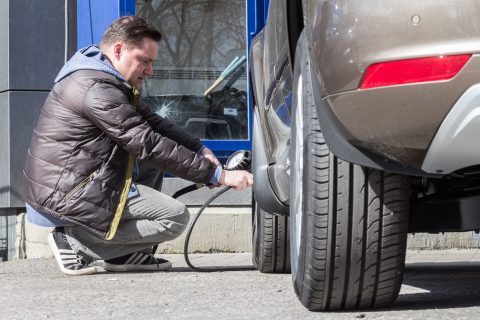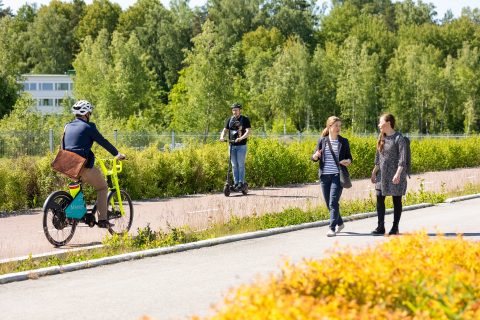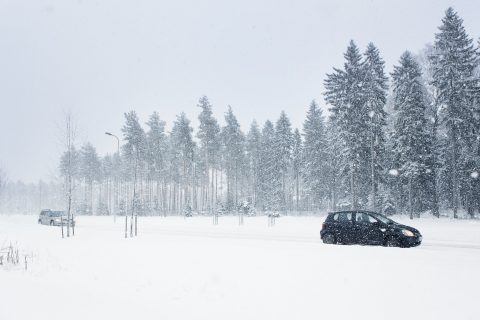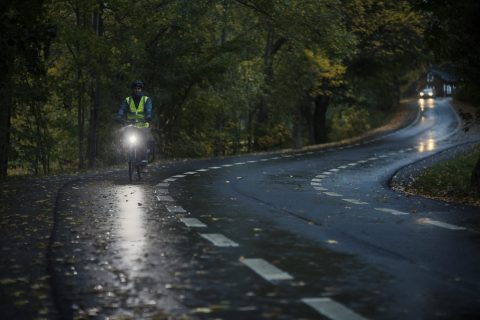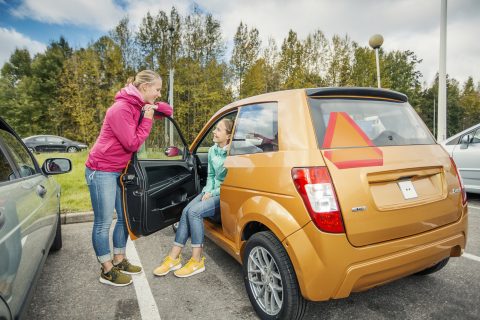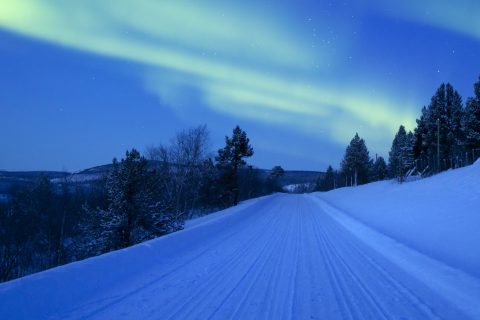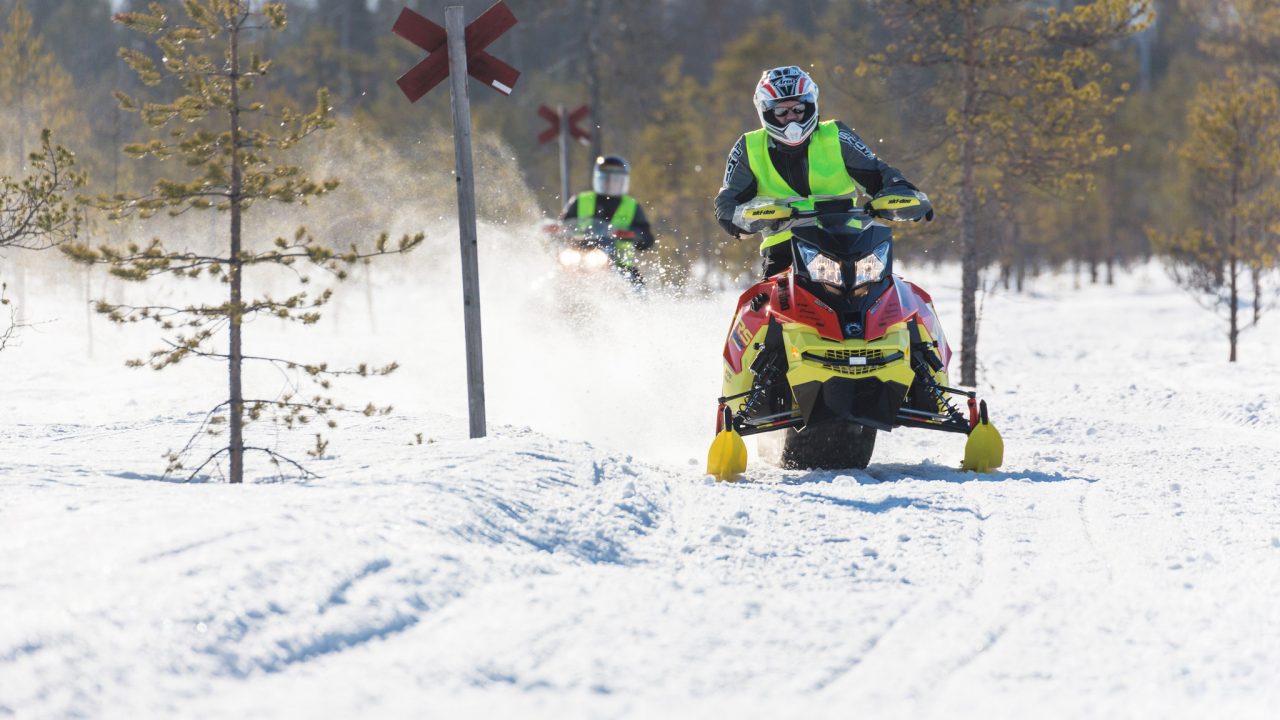
Snowmobiling
The driving environment of snowmobiles differs greatly from that of other vehicles. The snow-covered terrain in winter often looks deceptively safe. Safe driving requires knowledge of the hazards of off-road traffic, such as inappropriate situational speed and deficiencies in the snowmobile environment.
Who can drive a snowmobile
Off-road, snowmobiles may be driven by persons aged 15 or over. An exception to this rule is an area that can be closed, for example for driving practice. In this area, a person under 15 years of age may also practise safe snowmobiling. A private courtyard or, for instance, a field does not meet the criteria for a closed area. For example, an area enclosed with a fence is a closed area which can be restricted for access.
When driving on an official snowmobile route, the driver must have at least a category T driving licence. The official snowmobile route is indicated with a traffic sign (D8). If a snowmobile crosses a road or, in special exceptional situations permitted by law, is driven on the road, the driver must have at least a category T driving licence. Categories A1, A2, A and B also include category T. Category AM driving rights (e.g. moped licence, light motorised quadricycle licence) do not include category T driving rights. Read more about different driving license categories. (Opens in a new window)
The snowmobile driver must learn to use the snowmobile correctly and safely. The driver must also be aware of the traffic regulations for snowmobiling.
Where can you drive a snowmobile
Generally, a snowmobile may not be used on the road except for crossing a road or bridge. For example, if travelling on terrain is unreasonably difficult, or driving in a road area is considered necessary for crossing a road safely, the snowmobile may temporarily be driven on the road. In this case, the unploughed part of the road must primarily be used.
Riding a snowmobile in the terrain always requires permission from the landowner or land holder, but no permit is not needed on the driver’s personal property. Metsähallitus snowmobile tracks require a Metsähallitus track permit. For unofficial snowmobile tracks, the permit policy varies by region. A separate permit is not required when travelling on official snowmobile routes and in ice-covered waters. If there is an unofficial snowmobile track in the ice-covered area, a permit issued by the track operator is required when driving on it. A person driving a snowmobile on an official snowmobile route in the ice-covered area does not require a separate permit.
Efforts have been made to create routes where snowmobiles are mainly driven. This means that nature around the route will be harmed as little as possible. The majority of snowmobile fatalities occur in the ice-covered area. If there is uncertainty about the strength of the ice, a snowmobile should not be driven on it. For those driving on ice, it is recommended that awls are included in the safety equipment. The most important advice is that a snowmobile should not be driven in ice areas if there is uncertainty about the strength of the ice.
A proper snowmobile suit with reflectors increases safety. In many cases, snowmobile drivers receive injuries in the lower limbs, which means that protective snowmobile footwear will prevent serious injuries. In addition, appropriate driving gloves facilitate the handling of snowmobile controls.
Provisions on snowmobiling
The most important provisions governing snowmobile traffic are provided in the Road Traffic Act, off-road traffic acts and the Off-road Traffic Decree.
The helmet is the most important safety device for a snowmobile driver and is therefore mandatory for the driver and the passenger on board. The driver must ensure that a child under 15 years of age wears a protective helmet. The obligation to wear a helmet also applies to those travelling in an open sledge.
Speed limits for snowmobiling:
- The maximum permissible speed of a snowmobile on land terrain does not exceed 60 km/h,
- In exceptional cases, when driving on the road, up to 40 km/h,
- The speed in an ice-covered water area shall not exceed 80 km/h, but on the route the maximum permissible speed is 60 km/h, and
- If the snowmobile is connected to a sledge carrying passengers, the maximum permissible speed is 40 km/h.
The provisions on drink-driving also apply to snowmobiles, even in the terrain:
- The limit for drink-driving is 0.5 parts per thousand.
- The limit for aggravated drink-driving is 1.2 parts per thousand alcohol in blood.
- The consequences of drink-driving are similar to those for other traffic.
Typical snowmobile accidents
Snowmobile users are quite diverse a group. The group includes professionals in the field and those driving snowmobile rarely or for the first time. In recent years, 5–8 people have died each year in snowmobile accidents. Approximately 600 snowmobile accidents are compensated for annually by traffic insurance. More than 600 people receive compensation for personal injuries.
The number of serious accidents occurring in recreational snowmobiling is significantly higher than in professional or utility snowmobile traffic. The majority of fatalities and snowmobile accidents take place on ice during weekends. More than half of the snowmobile fatalities have been under the influence of alcohol. The most common cause of death in an ice-covered area is drowning.
Snowmobile accidents are typically characterised by excessive situational speeds and the lack or improper use of a protective helmet.
In less serious accidents, the incorrect use of controls has been detected among inexperienced drivers. For example, in a curve, the accelerator is unintentionally pressed down, resulting in a strong acceleration of the snowmobile, loss of control and derailment of the snowmobile.
